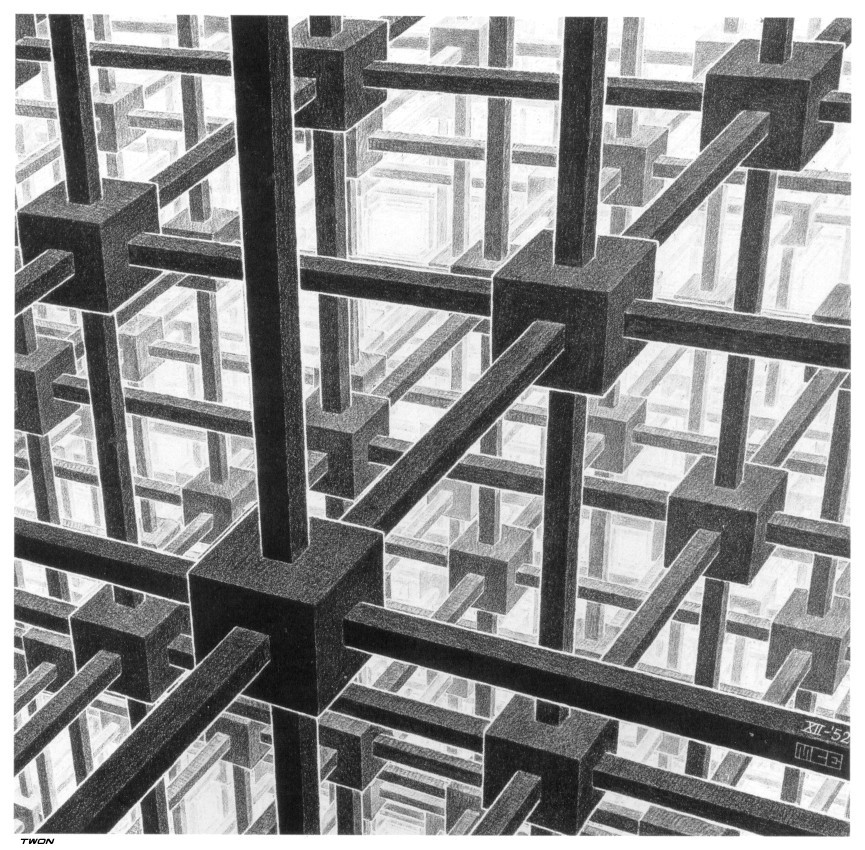
M.C. Escher, "Cubic Space Division", ©
| Site Map | Polytopes | Dynkin Diagrams | Vertex Figures, etc. | Incidence Matrices | Index |

M.C. Escher, "Cubic Space Division", ©
In contrast to tilings, honeycombs or tesselations of any other dimension, lattices are mere periodic point sets without any further elements and incidence structure. Periodicity here means, that whenever R1,0 is some being found point difference vector (R1,0 = r1 - r0), then not only q = r + R1,0 belongs to the same lattice for any lattice point r, but moreover any point qk = r + k R1,0 for any k ∈ ℤ. Now consider a corresponding difference vector subset, which makes up a base of the lattice. The whole lattice then happens to be nothing but the ℤ-span of that base. The base elements are called the primitive lattice vectors. For conveniance usually a lattice point at the origin is assumed, if not stated explicitly otherwise.
Most often a small change of coordinate values in the primitive vectors does not change the symmetry type of a lattice. A. Bravais not only listed these types for 3D, he also proved that there are exactly 14 of them (in that dimension). Accordingly the representants for either different symmetry type are nowadays called Bravais lattices, even within other dimensions.
A slightly larger vector subset than a mere base, in fact the closure of that base wrt. to reflection, then is called a root system. That is, whenever R and Q belongs to that set, then also does P, the reflection of Q wrt. to a hyperplane perpandicular to R. – Conversely, it is always possible to divide such a root system into 2 complemental subsets, a positive and a negative one. This can be done by selecting from a first direction either R or -R and then iteratively continuing this same selectioning under the additional restriction that for R and Q already being selected into one subset, that, whenever R + Q would be a root as well, then R + Q also has to be selected into the same. From these positive roots a still smaller subset of simple roots then can be defined in turn as those ones, which cannot be written as a sum of other positive ones. Such a set of simple roots then represents a lattice base again.
Most authors additionally distinguish between lattices and root lattices. But in view of the former definition of a root system there would be none. In fact those authors would include a further axiom into the notion of a root system. The complemental subset of authors instead would address that very notion as a crystallographic root system. This further axiom requires that for any Q, R from that root system (to be) the value 2 Q·R / R·R has to be an integer. I.e. Q and the reflection of Q wrt. to the hyperplane perpendicular to R have to produce a difference vector, which ought be an integral multiple of R. Accordingly, in view of the former paragraph, any lattice would be a root lattice. Whereas, in view of crystallography, only those, which bow to this additional restriction, can truely be attributed such. – Quite generally, any pair of roots provides that (then not necessarily integral) number. When being restricted to simple roots, i.e. a base, the set of those numbers in effect makes up a matrix, which is called the Cartan matrix. Note that this term, which is used as matrix entry, is clearly not symmetrical in R and Q; therefore the whole Cartan matrix too will not be symmetrical in general. – Sometimes also the mere matrix of the (unweighted) scalarproducts is referenced instead. That then is the associated Gram matrix. That one clearly is always symmetrical.
A further class of lattices is obtained by reciprocation. On the one hand the reciprocal lattice Λ* occurs by means of the Fourier transform of an according wavefunction based on any direct or position lattice Λ as the support for the resulting Bragg peaks in k-space. (By means of the quantum physical p = ℏk, that k-space sometimes also is refered to as momentum space.) In fact, when R is a period of the direct lattice, then also the wave functions of the two position vectors r resp. r + R ought provide the same values. Thus exp(i k·r) = exp(i k·(r+R)) = exp(i k·r) exp(i k·R), the last equal sign here just evaluates the rules of exponentiation, and therefore exp(i k·R) = 1. – Alternatively, and without that crystallographic referenece to Fourier transforms of wavefunctions, the reciprocal lattice can likewise be defined directly as Λ* = {k | k·R∈ℤ for all R∈Λ} (which then happens to coincide with the above description up to a global scaling factor of 2π). Within dimensions greater than 1 this k·R happens to be a scalar product, showing that generally corresponding base vectors of either space each have to have the same directions, but mutually being of inverse absolute size. – On the other hand this very mathematical description shows that the reciprocal of the reciprocal lattice then again happens to be the direct lattice again. And so there is no intrinsic preference between either one.
Wrt. (crystallographic) root lattices Λ the reciprocal lattice Λ* also is called a weight lattice. Right in this context it happens, that the root lattice itself always is a sublattice of its weight lattice. Moreover, the corresponding index | Λ* / Λ | is readily accessible by the determinant of the Cartan matrix of Λ. Weight lattices need no longer be crystallographic too, their Cartan matrix entries in general will become rationals. The exceptional lattices, where both are crystallographic, i.e. where | Λ* / Λ | = 1 (like for E8), are called unimodular.
Despite the fact that a lattice is a mere point set, there is a way how to associate a corresponding tesselation too. In fact, the Voronoi complex V(Λ) is a tesselation, defined by the individual Voronoi cells VR(Λ) are the closed subsets of embedding space (ℝ-span of Λ), which has lower or equal distance to some given lattice point R, than to any other one. The vertex set of the Voronoi complex, also refered to as the set of lattice holes, needs not be a lattice. That Voronoi complex moreover can be dualised (within that embedding space), resulting in the associated Delone complex D(Λ). The vertex set of this Delone complex for sure is the starting lattice again.
While within direct spaces to crystallographers the individual Voronoi cell also is known as Wigner-Size cell of the respective lattice, in reciprocal spaces it then is called its (first) Brillouin zone.
Besides of lattices in the above mathematical sense there are other high-symmetrical point sets too, which are for interest to crystallographers. Some of those got described on my page on non-lattices.
Root lattices are closely related to Weyl groups. In fact, the rotational and translatoric symmetries of a lattice are described by the associated Weyl group. Conversely, just as the finite Coxeter groups provide polytopes, the infinite Weyl groups also provide flat n-dimensional euclidean tesselations, some of which re-occur here as Delone complexes of a corresponding lattice. It is a matter of fact, that Weyl groups and the associated lattices generally are labeled exactly the same by the first few capital letters of the alphabet and the dimension of the spanned space is given as its subscript. (Some authors however try to distinguish this a little by using different fonts for either usage.)
It shall be warned here though, that the usage of Bn and Cn in literature tends to be mutually inverted sometimes, both from author to author, or even within a single monograph from chapter to chapter. The here provided attribution of Weyl groups (and hence for the to be assciated lattices) however is in accordance to Coxeter.
| Lattice | Simple Roots & Notes | Count & Hull of Roots | Cartan matrix |
| Weyl group | Voronoi complex V / Voronoi cell V0 | Delone complex D / Delone cells Dk | |
|
An (n ≥ 1) |
The simplest way to
describe An makes use of
A1 ≅ I1 ≅ ℤ | An* / An | = n+1 |
1D: 2 - {}
2D: 6 - {6}
3D: 12 - co
4D: 20 - spid
5D: 30 - scad
6D: 42 - staf
7D: 56 - suph
8D: 72 - soxeb
...
nD: n(n+1)
- x3o3o...3o3x (n nodes, n≥1)
expanded simplex
|
2 -1 0 0 0 ... -1 2 -1 0 0 ... 0 -1 2 -1 0 ... 0 0 -1 2 -1 ... 0 0 0 -1 2 ... ... |
o3o3o...3o3*a (n+1 nodes) |
V(A1) ≅ aze V0(A1) ≅ {} V(A2) ≅ hexat V0(A2) ≅ {6} V(A3) ≅ radh V0(A3) ≅ rad ... ≅ ... V0(A4) ≅ duspid V0(An) ≅ xo..oo3ox..oo3...3oo..xo3oo..ox&#zy (n node positions, n layers) where y = x/sqrt(n+1) : projection of (n+1)-dim. hypercube along body-diagonal : m3o...o3m (i.e. dual of x3o...o3x) |
D(A1) ≅ aze D1(A1) ≅ {} D(A2) ≅ trat D1(A2) ≅ {3} D2(A2) ≅ dual {3} D(A3) ≅ octet D1(A3) ≅ tet D2(A3) ≅ oct D3(A3) ≅ dual tet D(A4) ≅ cypit D1(A4) ≅ pen D2(A4) ≅ rap D3(A4) ≅ inv rap D4(A4) ≅ dual pen D(A5) ≅ cyxh D1(A5) ≅ hix D2(A5) ≅ rix D3(A5) ≅ dot D4(A5) ≅ inv rix D5(A5) ≅ dual hix D(A6) ≅ cyloh D1(A6) ≅ hop D2(A6) ≅ ril D3(A6) ≅ bril D4(A6) ≅ inv bril D5(A6) ≅ inv ril D6(A6) ≅ dual hop D(A7) ≅ cyooh ... ... D(An) ≅ x3o3o...3o3*a (n+1 nodes, n>1) Dk(An) : k-th layer section of (n+1)-dim. hypercube perp. to body-diagonal | |
|
Cn (n ≥ 2) |
Cn ≅ (A1)n ≅ ℤn
C2 ≅ ℤ[i] = {a+bi | a,b∈ℤ} | Cn* / Cn | = 2 (C1 = I1 ≅ A1 ≅ ℤ) |
large roots:
2D: 4 - {4}
3D: 12 - co
4D: 24 - ico
5D: 40 - rat
6D: 60 - rag
7D: 84 - rez
8D: 112 - rek
9D: 144 - riv
10D: 180 - rake
...
nD: 2n(n-1)
- o3x3o...3o4o (n nodes, n>2)
rectified crosspolytope
small roots just point to:
2D: 4 - side midpoints of {4}, i.e. dual {4}
3D: 6 - centers of {4} of co, i.e. oct
4D: 8 - centers of some oct of ico, i.e. hex
5D: 10 - centers of hex of rat, i.e. tac
6D: 12 - centers of tac of rag, i.e. gee
7D: 14 - centers of gee of rez, i.e. zee
8D: 16 - centers of zee of rek, i.e. ek
9D: 18 - centers of ek of riv, i.e. vee
10D: 20 - centers of vee of rake, i.e. ka
...
nD: 2n - centers of . x3o...3o4o
of o3x3o...3o4o
inscribed crosspolytope
|
...
... 2 -1 0 0 0
... -1 2 -1 0 0
... 0 -1 2 -1 0
... 0 0 -1 2 -2
... 0 0 0 -1 2
|
o4o3o3o...3o4o (n+1 nodes, n>1) |
V(C2) ≅ squat V0(C2) ≅ {4} V(C3) ≅ chon V0(C3) ≅ cube V(C4) ≅ test V0(C4) ≅ tes V(C5) ≅ penth V0(C5) ≅ pent V(C6) ≅ axh V0(C6) ≅ ax V(C7) ≅ hepth V0(C7) ≅ hept V(C8) ≅ och V0(C8) ≅ octo ... V(Cn) ≅ x4o3o3o...3o4o (n+1 nodes, n>1) : hypercubical honeycomb |
D(C2) ≅ squat D1(C2) ≅ {4} D(C3) ≅ chon D1(C3) ≅ cube D(C4) ≅ test D1(C4) ≅ tes D(C5) ≅ penth D1(C5) ≅ pent D(C6) ≅ axh D1(C6) ≅ ax D(C7) ≅ hepth D1(C7) ≅ hept D(C8) ≅ och D1(C8) ≅ octo ... D(Cn) ≅ x4o3o3o...3o4o (n+1 nodes, n>1) : hypercubical honeycomb | |
|
Bn (n ≥ 3) |
Bn ≅ {∑ciei ∈ ℤn+1 | ∑ci even}
B3 ≅ A3 ≅ fcc | Bn* / Bn | = 2 (B2 = A1×A1 ≅ C2)
|
large roots: 3D: 6 - oct 4D: 8 - hex 5D: 10 - tac 6D: 12 - gee 7D: 14 - zee 8D: 16 - ek 9D: 18 - vee 10D: 20 - ka ... nD: 2n - x3o3o...3o4o (n nodes, n>1) crosspolytope small roots just point to: 3D: 12 - edge midpoints of oct, i.e. co 4D: 24 - edge midpoints of hex, i.e. ico 5D: 40 - edge midpoints of tac, i.e. rat 6D: 60 - edge midpoints of gee, i.e. rag 7D: 84 - edge midpoints of zee, i.e. rez 8D: 112 - edge midpoints of ek, i.e. rek 9D: 144 - edge midpoints of vee, i.e. riv 10D: 180 - edge midpoints of ka, i.e. rake ... nD: 2n(n-1) - centers of x . .... . . of x3o3...o3o4o inscribed rectified crosspolytope |
...
... 2 -1 0 0 0
... -1 2 -1 0 0
... 0 -1 2 -1 0
... 0 0 -1 2 -1
... 0 0 0 -2 2
|
o3o3o *b3o...3o4o (n+1 nodes, n>3) |
V(B3) ≅ radh V0(B3) ≅ rad V(B4) ≅ icot V0(B4) ≅ ico ... V0(Bn) ≅ qo3oo3...3oo4ox&#zy (n node positions) where y = x sqrt(n+1)/2 |
D(B3) ≅ octet D1(B3) ≅ tet D2(B3) ≅ oct D(B4) ≅ hext D1(B4) ≅ hex D(B5) ≅ hinoh D1(B5) ≅ hin D2(B5) ≅ tac D(B6) ≅ haxh D1(B6) ≅ hax D2(B6) ≅ gee ... D(Bn) ≅ x3o3o *b3o...3o4o (n+1 nodes, n>2) : demi-hypercubical honeycomb | |
|
Dn (n ≥ 4) |
Dn ≅ {∑ciei ∈ ℤn | ∑ci even} D4 ≅ F4 | Dn* / Dn | = 4 (D3 = A3 ≅ B3 ≅ fcc) |
4D: 24 - ico 5D: 40 - rat 6D: 60 - rag 7D: 84 - rez 8D: 112 - rek 9D: 144 - riv 10D: 180 - rake ... nD: 2n(n-1) - o3x3o...3o4o (n nodes, n>2) rectified crosspolytope |
...
... 2 -1 0 0 0
... -1 2 -1 0 0
... 0 -1 2 -1 -1
... 0 0 -1 2 0
... 0 0 -1 0 2
|
o3o3o o3o3o *b3o...3*e (n+1 nodes, n>4) resp. o3o3o *b3o *b3o (n=4) |
V(D4) ≅ icot V0(D4) ≅ ico ... V0(Dn) ≅ xoo3ooo3oxo *b3ooo...ooo3oox&#zy (n node positions) where y = x sqrt[(n+1)/8] |
D(D4) ≅ hext D1(D4) ≅ hex D(D5) ≅ hinoh D1(D5) ≅ hin D2(D5) ≅ tac D(D6) ≅ haxh D1(D6) ≅ hax D2(D6) ≅ gee ... D(Dn) ≅ x3o3o o3o3o *b3o...3*e (n+1 nodes, n>4) : demi-hypercubical honeycomb | |
| E6 |
| E6* / E6 | = 3
(E5 = D5 |
72 - mo - o3o3o3o3o *c3x Gosset polypeton 12,2 |
2 -1 0 0 0 0 -1 2 -1 0 0 0 0 -1 2 -1 -1 0 0 0 -1 2 0 0 0 0 -1 0 2 -1 0 0 0 0 -1 2 |
o3o3o3o3o *c3o3o |
V(E6) ≅ reciprocal(22,2) |
D(E6) ≅ jakoh D1(E6) ≅ jak Gosset hexacomb 22,2 Gosset polypeton 22,1 D2(E6) ≅ gyrated jak Gosset polypeton 21,2 | |
| E7 |
| E7* / E7 | = 2 |
126 - laq - x3o3o3o *c3o3o3o Gosset polyexon 23,1 |
2 -1 0 0 0 0 0 -1 2 -1 0 0 0 0 0 -1 2 -1 0 0 0 0 0 -1 2 -1 -1 0 0 0 0 -1 2 0 0 0 0 0 -1 0 2 -1 0 0 0 0 0 -1 2 |
o3o3o3o3o3o3o *d3o |
... |
D(E7) ≅ naquoh D1(E7) ≅ oca Gosset heptacomb 33,1 Gosset polyexon 33,0 (= simplex) D2(E7) ≅ naq Gosset polyexon 32,1 | |
| E8 |
| E8* / E8 | = 1 |
240 - fy - o3o3o3o *c3o3o3o3x Gosset polyzetton 42,1 |
2 -1 0 0 0 0 0 0 -1 2 -1 0 0 0 0 0 0 -1 2 -1 0 0 0 0 0 0 -1 2 -1 0 0 0 0 0 0 -1 2 -1 -1 0 0 0 0 0 -1 2 0 0 0 0 0 0 -1 0 2 -1 0 0 0 0 0 0 -1 2 |
o3o3o3o *c3o3o3o3o3o |
... |
D(E8) ≅ goh D1(E8) ≅ ene Gosset octacomb 52,1 Gosset polyzetton 52,0 (= simplex) D2(E8) ≅ ek Gosset polyzetton 51,1 (= cross-polytope) | |
| F4 |
F4 ≅ B4 ≅ D4 | F4* / F4 | = 1 |
large roots: 24 - ico small roots: 24 - centers of oct of ico inscribed dually oriented ico |
2 -1 0 0 -1 2 -2 0 0 -1 2 -1 0 0 -1 2 |
o3o3o4o3o |
V(F4) ≅ icot : icositetrachoric tetracomb |
D(F4) ≅ hext : hexadecachoric tetracomb | |
| G2 |
One way to
describe G2 makes use of
G2 ≅ A2 | G2* / G2 | = 1 |
large roots: 6 - u6o small roots: 6 - o6x dual hexagon of halved sides |
2 -1 -3 2 |
o3o6o |
V(G2) ≅ hexat = o3o6x |
D(G2) ≅ trat = x3o6o | |
| I1 |
I1 = ℤ ≅ A1 ≅ B1 ≅ C1 | I1* / I1 | = 1 |
2 - x |
2 |
o-∞-o |
V(I1) ≅ o-∞-x |
D(I1) ≅ x-∞-o | |
|
reducible Λ × Λ' |
|
N(Λ) ⊕ N(Λ') - ... tegum product of components |
Cart(Λ) 0 0 Cart(Λ') |
Weyl(Λ) × Weyl(Λ') |
V(Λ × Λ') ≅ V(Λ) × V(Λ') honeycomb product of components eg. V(A2×A2) = o3o6x o3o6x (hibbit) |
D(Λ × Λ') ≅ D(Λ) × D(Λ') honeycomb product of components eg. D(A2×A2) = x3o6o x3o6o (tribbit) |
The latter entry shows that the individual Voronoi cells will be isohedral, iff the lattice is a root lattice or a direct product of identical root lattices.
A directly constructed base for the dual lattices can easily be derived from its associated original one: If B is the matrix of column vectors of the original lattice base, then A = (B-1)T clearly is the matrix of column vectors of the reciprocal lattice. (For, the scalar products, required in the definition of the reciprocal lattice, are just the entries of the matrix ATB, which, by the above choice, just happens to be the identity matrix.)
On the other hand, for weight lattices we know already that the corresponding root lattice defines a subset of points. Thus it might be more direct to provide the further generators only, instead.
| Lattice | Quotient | Further generator(s) | Overlay as compounded vertex set |
| Voronoi complex V / Voronoi cell V0 | Delone complex D / Delone cells Dk | ||
|
An* (n ≥ 1) |
An* / An ≅ ℤn+1
Just as An was best
A1* ≅ A1 ≅ ℤ |
|
xoo...o-3-oxo...o-3-oox...o- ... -ooo...x-3-*a (n+1 compound components, n+1 node positions) |
V(A1*) ≅ aze V0(A1*) ≅ {} V(A2*) ≅ hexat V0(A2*) ≅ {6} V(A3*) ≅ batch V0(A3*) ≅ toe V(A4*) ≅ otcypit V0(A4*) ≅ gippid V(A5*) ≅ gapcyxh V0(A5*) ≅ gocad V(A6*) ≅ otcyloh V0(A6*) ≅ gotaf ... V0(A7*) ≅ guph V0(A8*) ≅ goxeb ... V(An*) ≅ x3x3...x3*a (n+1 nodes) V0(An*) is also known as the n-dimensional permutotope of order n+1, as its vertices represent all permutations of n+1 elements, while its edges correspond to their transpositions. |
D(A1*) ≅ aze D(A2*) ≅ trat D(A3*) ≅ bichon ... | ||
|
Cn* (n ≥ 2) |
Cn* / Cn ≅ ℤ2 bodycentered hypercubic
C2* ≅ C2 (rotoscaled) |
|
xo-4-oo-3-oo- ... -oo-4-ox |
V(C2*) ≅ squat V0(C2*) ≅ {4} V(C3*) ≅ batch V0(C3*) ≅ toe V(C4*) ≅ icot V0(C4*) ≅ ico V(C5*) ≅ titanoh V0(C5*) ≅ bittit V(C6*) ≅ traxh V0(C6*) ≅ brag ... V0(C7*) ≅ totaz V0(C8*) ≅ tark ... V(C2m*) ≅ o4o3o...o3x3o...o3o4o V(C2m+1*) ≅ o4o3o...o3x3x3o...o3o4o(m>1 nodes unringed on either side) V(C2*) ≅ o4x4o V(C3*) ≅ o4x3x4o(m=1) |
D(C2*) ≅ squat D(C3*) ≅ bichon ... | ||
|
Bn* (n ≥ 3) |
Bn* / Bn ≅ ℤ2 primitive hypercubic Bn* ≅ Cn ≅ (A1)n ≅ ℤn |
|
xo-3-oo-3-ox *b3-oo-...-oo-4-oo(n+1 node positions, n≥3) |
V(B3*) ≅ chon V0(B3*) ≅ cube V(B4*) ≅ test V0(B4*) ≅ tes V(B5*) ≅ penth V0(B5*) ≅ pent V(B6*) ≅ axh V0(B6*) ≅ ax V(B7*) ≅ hepth V0(B7*) ≅ hept V(B8*) ≅ och V0(B8*) ≅ octo ... V(Bn*) ≅ o3o3o *b3o...o3o4x |
D(B3*) ≅ chon D1(B3*) ≅ cube D(B4*) ≅ test D1(B4*) ≅ tes D(B5*) ≅ penth D1(B5*) ≅ pent D(B6*) ≅ axh D1(B6*) ≅ ax D(B7*) ≅ hepth D1(B7*) ≅ hept D(B8*) ≅ och D1(B8*) ≅ octo ... | ||
|
Dn* (n ≥ 4) |
Dn* / Dn ≅ ℤ4 (n odd) bodycentered hypercubic Dn* ≅ Cn* |
|
xooo-3-oooo-3-oxoo ooxo-3-oooo-3-ooox *b-3-oooo-....-oooo-3*e(n+1 node positions, n>4) xooo-3-oooo-3-oxoo *b-3-ooxo *b-3-ooox(n=4) |
V(D4*) ≅ icot V0(D4*) ≅ ico V(D5*) ≅ titanoh V0(D5*) ≅ bittit V(D6*) ≅ traxh V0(D6*) ≅ brag ... V0(D7*) ≅ totaz V0(D8*) ≅ tark ... V(D2m*) ≅ o3o3o o3o3o *b3o...o3x3o...o3*e V(D2m+1*) ≅ o3o3o o3o3o *b3o...o3x3x3o...o3*e(m>2 nodes unringed on either side) V(D4*) ≅ o3x3o *b3o *b3o V(D5*) ≅ o3x3o o3x3o *b3*e(m=2) |
... | ||
| E6* |
E6* / E6 ≅ ℤ3 |
|
xoo-3-ooo-3-ooo-3-ooo-3-oxo *c-3-ooo-3-oox |
V(E6*) ≅ ramoh V0(E6*) ≅ ram Gosset hexacomb 02,2,2 Gosset polypeton 02,2,1 |
... | ||
| E7* |
E7* / E7 ≅ ℤ2 |
|
xo-3-oo-3-oo-3-oo-3-oo-3-oo-3-ox *d-3-oo |
V(E7*) ≅ linoh V0(E7*) ≅ lin Gosset heptacomb 13,3 Gosset polyexon 13,2 |
... |
The cases E8* ≅ E8, F4* ≅ F4, G2* ≅ G2, and I1* ≅ I1 can be omitted in the above table for obvious reasons.
In 1990 Steve Waterman came up with an idea, which, generalized in the comunity of the Polyhedron Maillist Archive in November 2006, then became known as the (generalized) waterman polyhedra – or even more general: polytopes. This idea simply starts with any lattice (while Waterman originally considered FCC only) plus any "center point" chosen somewhere therein. Next a sphere of some given radius around that center point will select a (finite) subset of contained lattice points. The hull of these selected points then is the respective waterman polyhedron.
As it is obvious, the more symmetrically chosen "center points", like the lattice points themselves or the (shallow, deep, ...) holes etc., would result within more interesting, i.e. more symmetrical polyhedra, while more general "center points" would produce less interesting, asymmetrical polyhedra. Note further that this setup, while outlined above wrt. 3D lattices only, does well extend to any dimension likewise.
The following small interactive VRML in those days was designed, displaying the contained point sets for the 3D primitive cubic, face-centered cubic, and body-centered cubic lattice wrt. the center point being a lattice point, as well as the former two thereof wrt. the center being a hole and a deep hole respectively. (The polyhedra according to the shallow holes in the second and the holes in the latter case would turn out subsymmetrical only and thence then got not displayed therein, however get listed below.)
⭳
The counts of contained lattice points each provide distinct discrete series wrt. continuously increasing radius, when considered for specific lattices and center points. Several of such series already are listed within the online encyclopedia of integer sequences and hence get refered below by their OEIS number accordingly.
| 2D Lattice | Center | Number | min. Radius | Count of points | Hull | Example |
|
C2 (squat) unit = square edge |
lattice point (full o4o sym.) | 0 | 0 | 1 | o4o - point |
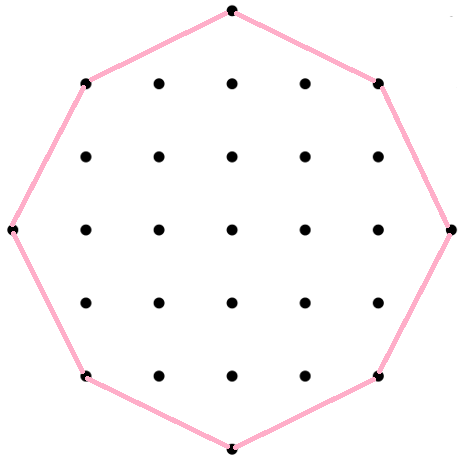 Uo4oD&#zh |
| 1 | 1 | +4 = 5 | o4q - square | |||
| 2 | sqrt(2) = 1.414214 | +4 = 9 | u4o - square | |||
| 3 | 2 | +4 = 13 |
o4Q - square with Q = 2q = 2sqrt(2) | |||
| 4 | sqrt(5) = 2.236068 | +8 = 21 | u4q | |||
| 5 | sqrt(8) = 2.828427 | +4 = 25 |
U4o - square with U = 2u = 4 | |||
| 6 | 3 | +4 = 29 |
Uo4oD&#zh with D = dq = 3sqrt(2), U = 2u = 4 | |||
| 7 | sqrt(10) = 3.162278 | +8 = 37 |
u4Q with Q = 2q = 2sqrt(2) | |||
| 8 | sqrt(13) = 3.605551 | +8 = 45 |
U4q with U = 2u = 4 | |||
| ... | OEIS A057961 | |||||
|
hole (full o4o sym.) | 1 | 1/sqrt(2) = 0.707107 | 4 | x4o - square |
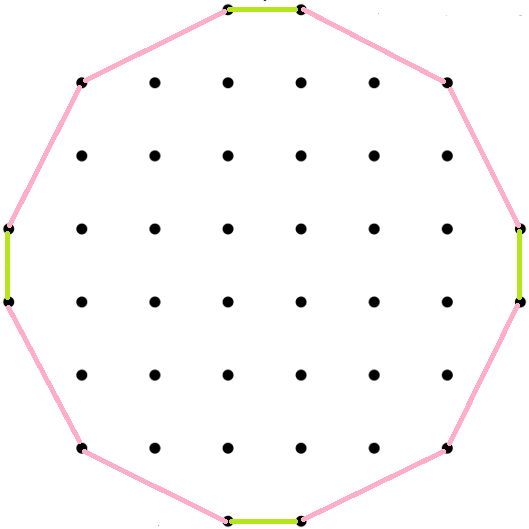 Px4oD&#zh | |
| 2 | sqrt(5/2) = 1.581139 | +8 = 12 | x4q | |||
| 3 | 3/sqrt(2) = 2.121320 | +4 = 16 |
d4o - square with d = 3 | |||
| 4 | sqrt(13/2) = 2.549510 | +8 = 24 |
x4Q with Q = 2q = 2sqrt(2) | |||
| 5 | sqrt(17/2) = 2.915476 | +8 = 32 |
d4q with d = 3 | |||
| 6 | 5/sqrt(2) = 3.535534 | +12 = 44 |
Px4oD&#zh with P = 5, D = dq = 3sqrt(2) | |||
| 7 | sqrt(29/2) = 3.807887 | +8 = 52 |
d4Q with d = 3, Q = 2q = 2sqrt(2) | |||
| ... | OEIS A057962 | |||||
|
A2 (trat) unit = square edge |
lattice point (full o6o sym.) | 0 | 0 | 1 | o6o - point | |
| 1 | 1 | +6 = 7 | x6o - hexagon | |||
| 2 | sqrt(3) = 1.732051 | +6 = 13 | o6h - hexagon | |||
| 3 | 2 | +6 = 19 | u6o - hexagon | |||
| 4 | sqrt(7) = 2.645751 | +12 = 31 | x6h | |||
| 5 | 3 | +6 = 37 |
d6o - hexagon with d = 3 | |||
| 6 | sqrt(12) = 3.464102 | +6 = 43 |
o6H - hexagon with H = 2h = 2sqrt(3) | |||
| 7 | sqrt(13) = 3.605551 | +12 = 55 | u6h | |||
| 8 | 4 | +6 = 61 |
U6o - hexagon with U = 2u = 4 | |||
| ... | OEIS A038590 |
hole (full o3o sym.) | 1 | 1/sqrt(3) = 0.577350 | 3 | x3o - triangle |
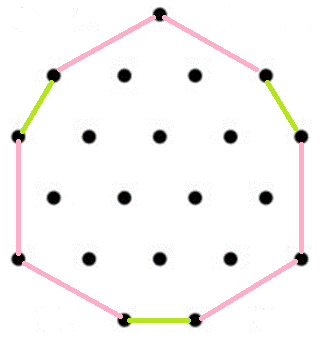 Ux3od&#zh 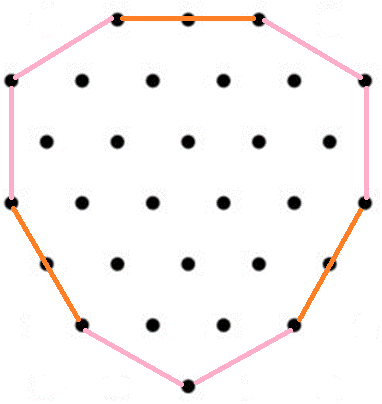 do3uP&#zh 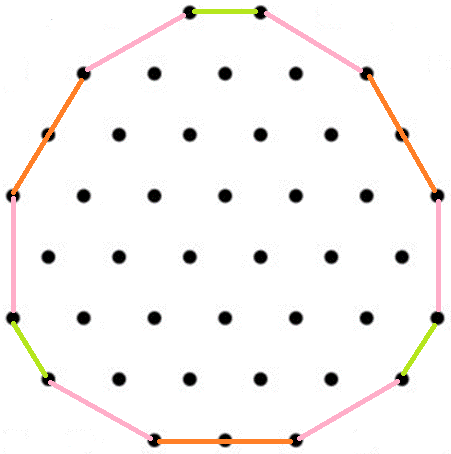 uP3Ux&#zh |
| 2 | sqrt(4/3) = 1.154701 | +3 = 6 | o3u - triangle | |||
| 3 | sqrt(7/3) = 1.527525 | +6 = 12 | u3x | |||
| 4 | sqrt(13/3) = 2.081666 | +6 = 18 |
x3d with d = 3 | |||
| 5 | 4/sqrt(3) = 2.309401 | +3 = 21 |
Ux3od&#h with d = 3, U = 2u = 4 | |||
| 6 | sqrt(19/3) = 2.516611 | +6 = 27 |
d3u with d = 3 | |||
| 7 | 5/sqrt(3) = 2.886751 | +3 = 30 |
do3uP&#zh with d = 3, P = 5 | |||
| 8 | sqrt(28/3) = 3.055050 | +6 = 36 |
u3U with U = 2u = 4 | |||
| 9 | sqrt(31/3) = 3.214550 | +6 = 42 |
uP3Ux&#zh with U = 2u = 4, P = 5 | |||
| ... | OEIS A038588 | |||||
| 3D Lattice | Center | Number | min. Radius | Count of points | Hull | Example |
|
C3 (primitive cubic) unit = cube edge |
lattice point (full o3o4o sym.) | 0 | 0 | 1 | point |
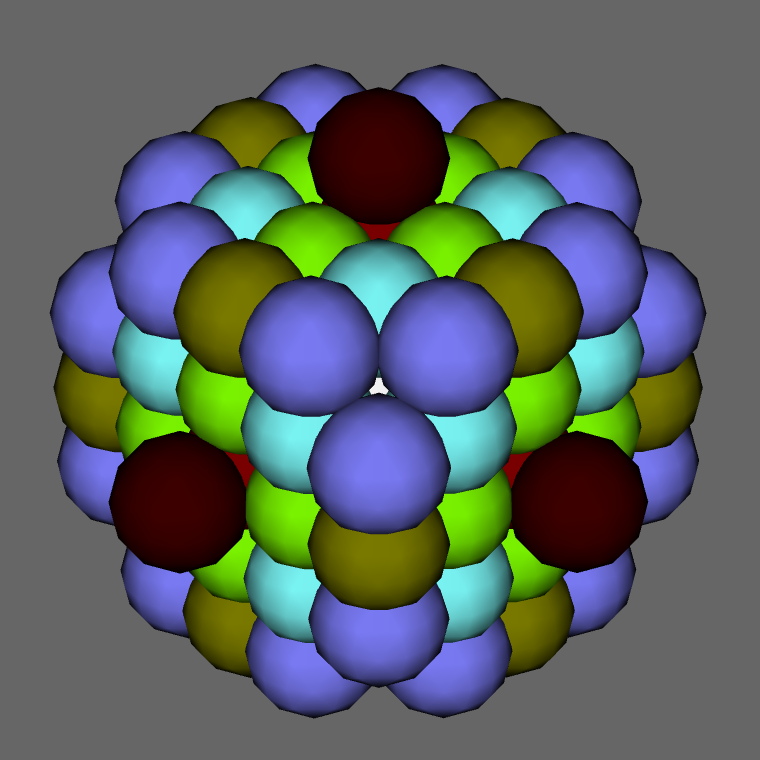 Zo3oq4ou&#zb |
| 1 | 1 | +6 = 7 | q3o4o - oct | |||
| 2 | sqrt(2) = 1.414214 | +12 = 19 | o3q4o - co | |||
| 3 | sqrt(3) = 1.732051 | +8 = 27 | o3o4u - cube | |||
| 4 | 2 | +6 = 33 |
Qo3oo4ou&#zh - rad with Q = 2sqrt(2) (pseudo) | |||
| 5 | sqrt(5) = 2.236068 | +24 = 57 | q3q4o - toe | |||
| 6 | sqrt(6) = 2.449490 | +24 = 81 | q3o4u | |||
| 7 | sqrt(8) = 2.828427 | +12 = 93 | o3Q4o - co | |||
| 8 | 3 | +30 = 123 |
Zo3oq4ou&#zb where: Z = 3sqrt(2) (pseudo), b = sqrt(6) | |||
| ... | OEIS A117609 | |||||
|
hole (full o3o4o sym.) | 1 | sqrt(3)/2 = 0.866025 | 8 | o3o4x - cube | ||
| 2 | sqrt(11)/2 = 1.658312 | +24 = 32 | q3o4x | |||
| 3 | sqrt(19)/2 = 2.179449 | +24 = 56 | o3q4x | |||
| 4 | sqrt(27)/2 = 2.598076 | +32 = 88 |
Qo3oo4xd&#zh where: Q = 2sqrt(2) and d = 3 (pseudo) | |||
| 5 | sqrt(35)/2 = 2.958040 | +48 = 136 | q3q4x | |||
| ... | ||||||
|
A3 (face-centered cubic) unit = root |
lattice point (full o3o4o sym.) | 0 | 0 | 1 | point |
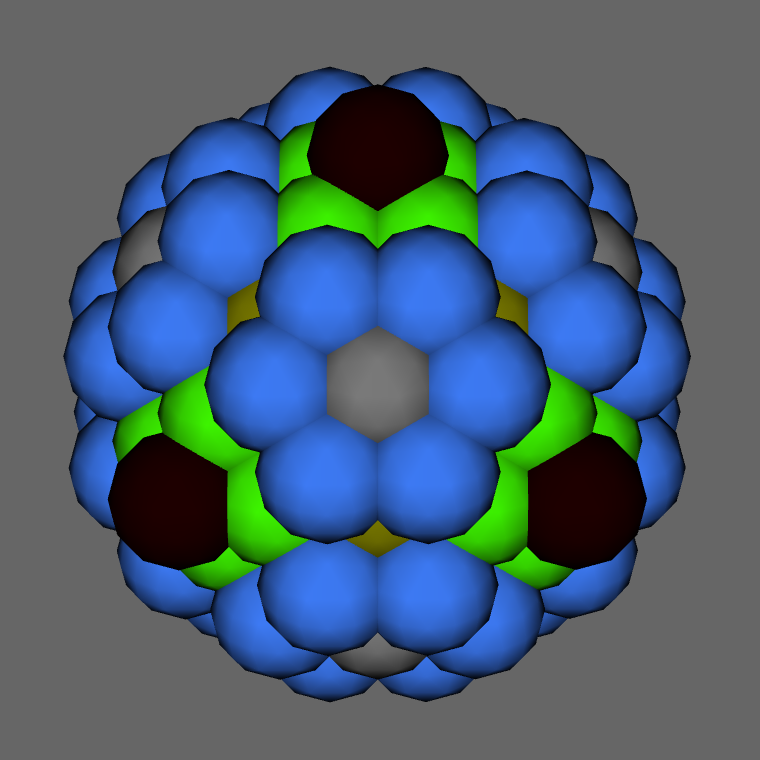 ax3ox4oq&#zh |
| 1 | 1 | +12 = 13 | o3x4o - co | |||
| 2 | sqrt(2) = 1.414214 | +6 = 19 | u3o4o - oct | |||
| 3 | sqrt(3) = 1.732051 | +24 = 43 | reco | |||
| 4 | 2 | +12 = 55 | o3u4o - co | |||
| 5 | sqrt(5) = 2.236068 | +24 = 79 | u3x4o | |||
| 6 | sqrt(6) = 2.449490 | +8 = 87 |
uo3xo4oQ&#zh where: Q = 2sqrt(2) (pseudo) | |||
| 7 | sqrt(7) = 2.645751 | +48 = 135 | x3x4q | |||
| 8 | sqrt(8) = 2.828427 | +6 = 141 |
ax3ox4oq&#zh where: a = 4 (pseudo) | |||
| 9 | 3 | +36 = 177 |
od3do4oq&#zh where: d = 3 (pseudo) | |||
| 10 | sqrt(10) = 3.162278 | +24 = 201 | u3u4o - toe | |||
| ... | OEIS A119869 | |||||
|
deep hole (full o3o4o sym.) | 1 | 1/sqrt(2) = 0.707107 | 6 | x3o4o - oct |
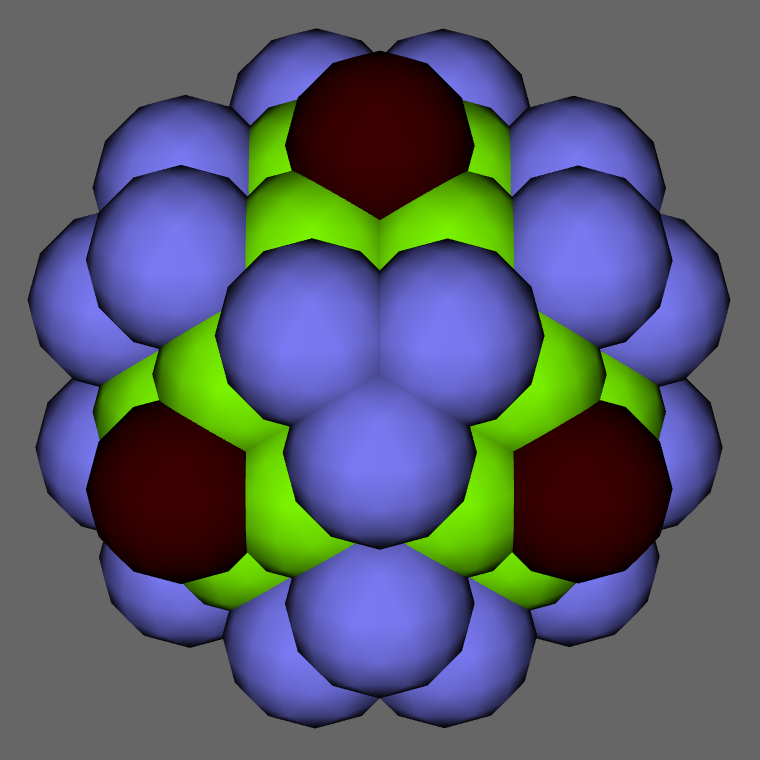 do3ox4oq&#zh | |
| 2 | sqrt(3/2) = 1.224745 | +8 = 14 | o3o4q - cube | |||
| 3 | sqrt(5/2) = 1.581139 | +24 = 38 | x3x4o - toe | |||
| 4 | 3/sqrt(2) = 2.121320 | +30 = 68 |
do3ox4oq&#zh where: d = 3 (pseudo) | |||
| ... | OEIS A119874 | |||||
|
shallow hole (o3o3o subsym.) | 1 | sqrt(3/8) = 0.612372 | 4 | x3o3o - tet | ||
| 2 | sqrt(11/8) = 1.172604 | +12 = 16 | x3x3o - tut | |||
| 3 | sqrt(19/8) = 1.541104 | +12 = 28 | u3o3x | |||
| 4 | sqrt(27/8) = 1.837117 | +16 = 44 |
ox3ou3do&#zh where: d = 3 (pseudo) | |||
| 5 | sqrt(35/8) = 2.091650 | +24 = 68 | x3x3u | |||
| ... | OEIS A121054 | |||||
|
C3* (body-centered cubic) unit = cube edge |
lattice point (full o3o4o sym.) | 0 | 0 | 1 | point |
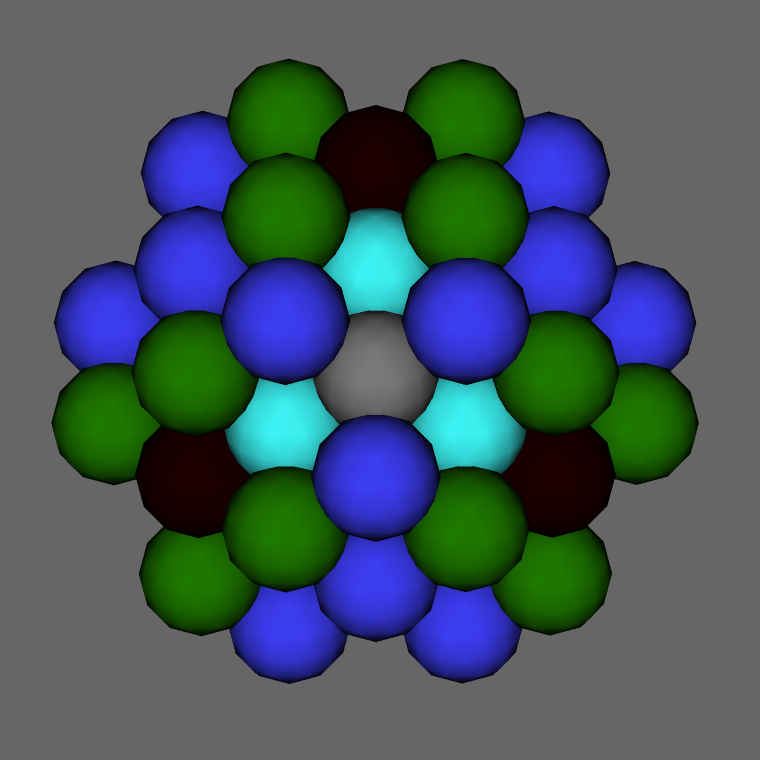 qo3qq4ox&#zc |
| 1 | sqrt(3)/2 = 0.866025 | +8 = 9 | o3o4x - cube | |||
| 2 | 1 | +6 = 15 |
qo3oo4ox&#zc - rad where: c = sqrt(3)/2, q (pseudo) | |||
| 3 | sqrt(2) = 1.414214 | +12 = 27 | o3q4o - co | |||
| 4 | sqrt(11)/2 = 1.658312 | +24 = 51 | q3o4x | |||
| 5 | sqrt(3) = 1.732051 | +8 = 59 |
oq3oo4ux&zc where: c = sqrt(3)/2; q and u (pseudo) | |||
| 6 | 2 | +6 = 65 |
Qo3oo4ou&#zh - rad where: Q = 2sqrt(2) (pseudo) | |||
| 7 | sqrt(19)/2 = 2.179449 | +24 = 89 |
Qo3oq4ox&#ze where: Q = 2sqrt(2) (pseudo), e = sqrt(11)/2 | |||
| 8 | sqrt(5) = 2.236068 | +24 = 113 |
qo3qq4ox&#zc where: c = sqrt(3)/2 | |||
| ... | ||||||
|
hole (o o4o subsym.) | 1 | 1/2 = 0.5 | 2 | x o4o - line | ||
| 2 | 1/sqrt(2) = 0.707107 | +4 = 6 |
xo ox4oo&#zc - squit where: c = sqrt(3)/2 | |||
| 3 | sqrt(5)/2 = 1.118034 | +8 = 14 | x q4o | |||
| 4 | sqrt(3/2) = 1.224745 | +8 = 22 |
xu ox4qo&#zc where: c = sqrt(3)/2 | |||
| ... | ||||||
| 4D Lattice | Center | Number | min. Radius | Count of points | Hull |
|
C4 (primitive tessic) unit = tesseract edge |
lattice point (full o3o3o4o sym.) | 0 | 0 | 1 | point |
| 1 | 1 | +8 = 9 | q3o3o4o - hex | ||
| 2 | sqrt(2) = 1.414214 | +24 = 33 | o3q3o4o - ico | ||
| 3 | sqrt(3) = 1.732051 | +32 = 65 | o3o3q4o - rit | ||
| 4 | 2 | +24 = 89 | o3u3o4o - ico | ||
| 5 | sqrt(5) = 2.236068 | +48 = 137 | oq3oq3oo4uo&#zh | ||
| 6 | sqrt(6) = 2.449490 | +96 = 233 | q3o3q4o - rico | ||
| ... | OEIS A046895 | ||||
|
hole (full o3o3o4o sym.) | 1 | 1 | 16 | o3o3o4x - tes | |
| 2 | sqrt(3) = 1.732051 | +64 = 80 | q3o3o4x | ||
| 3 | sqrt(5) = 2.236068 | +96 = 176 | o3q3o4x | ||
| 4 | sqrt(7) = 2.645751 | +128 = 304 | Qo3oo3oq4xx&#zh | ||
| 5 | 3 | +208 = 512 | oq3oq3oo4dx&#zh | ||
| ... | |||||
|
D4 (alternated tessic) unit = tesseract's square diagonal |
lattice point (full o3o4o3o sym.) | 0 | 0 | 1 | point |
| 1 | 1 | +24 = 25 | x3o4o3o - ico | ||
| 2 | sqrt(2) = 1.414214 | +24 = 49 | o3o4o3q - (dual) ico | ||
| 3 | sqrt(3) = 1.732051 | +96 = 145 | o3x4o3o - rico | ||
| 4 | 2 | +24 = 169 | u3o4o3o - ico | ||
| 5 | sqrt(5) = 2.236068 | +144 = 313 | x3o4o3q | ||
| 6 | sqrt(6) = 2.449490 | +96 = 409 | o3o4q3o - (other) rico | ||
| ... | OEIS A046949 | ||||
|
hole (o3o3o4o subsym.) | 1 | 1/sqrt(2) = 0.707107 | 8 | x3o3o4o - hex | |
| 2 | sqrt(3/2) = 1.224745 | +32 = 40 | o3o3x4o - rit | ||
| 3 | sqrt(5/2) = 1.581139 | +48 = 88 | x3x3o4o - thex | ||
| 4 | sqrt(7/2) = 1.870829 | +128 = 216 | 1/q-scaled oq3oo3qo4xu&#zx | ||
| 5 | 3/sqrt(2) = 2.121320 | +104 = 320 | do3ox3ox4oo&#zh | ||
| ... | |||||
|
A4 (cyclo pennic) unit = pentachoron edge |
lattice point (double o3o3o3o sym.) | 0 | 0 | 1 | point |
| 1 | 1 | +20 = 21 | x3o3o3x - spid | ||
| 2 | sqrt(2) = 1.414214 | +30 = 51 | o3x3x3o - deca | ||
| 3 | sqrt(3) = 1.732051 | +60 = 111 | uo3ox3xo3ou&#zq | ||
| 4 | 2 | +60 = 171 | xuo3uoo3oou3oux&#z(qqh) | ||
| ... | |||||
|
deep hole (single o3o3o3o sym.) | 1 | sqrt(3/5) = 0.774597 | 10 | o3x3o3o - rap | |
| 2 | sqrt(8/5) = 1.264911 | +20 = 30 | o3o3x3x - tip | ||
| 3 | sqrt(13/5) = 1.612452 | +60 = 90 | x3x3o3x - prip | ||
| ... | |||||
|
shallow hole (single o3o3o3o sym.) | 1 | sqrt(2/5) = 0.632456 | 5 | x3o3o3o - pen | |
| 2 | sqrt(7/5) = 1.183216 | +30 = 35 | o3x3o3x - srip | ||
| ... | |||||
© 2004-2025 | top of page |